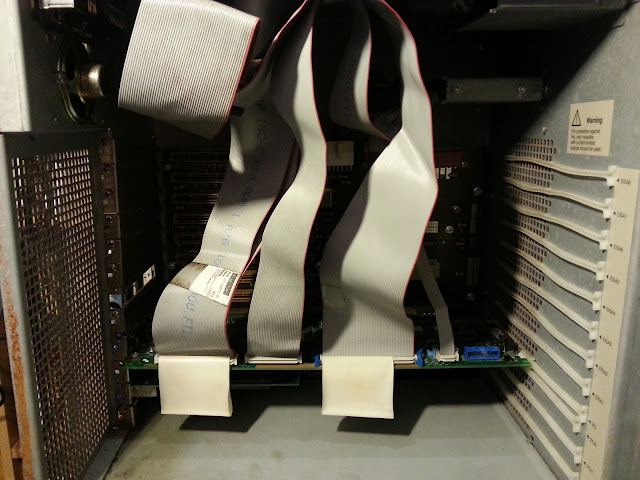I had to fabricate an MMJ to MMJ cable. I used 6-core telephone wire from Maplins, and two normal phone jacks. Each phone jack underwent simple surgery to allow them to fit into the funny MMJ jack socket. The wires were hand-crimped into the jacks using a razorblade and a hammer. A continuity test with a multimeter on both ends of the cable proved successful, and use of the H8571-J to connect the terminal to a DS10L's serial port worked first time! Yay for small victories!
For the AlphaServer 2100 itself, Peter in Ireland has been incredibly helpful recently. He measured the voltages at the OCP connector during use:
1. 12V when system is on. 0v when system is off.
2. 5.2V when system is on. 0v when system is off.
3. 0V
4. 5.2V when system is on. 0v when system is off.
5. 0V
6. 5.2V when system is on. 0v when system is off.
7. 3.5V when system is on, dipping momentarily when reset is pressed.
8. 4.8V when system is on, varying when the display changes
9. 4.8V when system is on, varying when the display changes.
10. 0.5V when power switch and door interlock are engaged, otherwise 2V
When I did the same, I found that my pin 7 was 0.3V, corresponding to the permanent SYSTEM RESET message on the OCP. This (to cut a long story short) allowed us to conclude that my existing two IO boards were faulty. He's been having fun himself, getting his second CPU to show up in VMS but that will come later in our story.
Shortly after concluding the IO boards were dead, the third IO board arrived and: it worked! It showed TEST CPU messages on the OCP, then TEST MEM messages! Hoorah!
Then FAIL MEM! Ah. Bugger.
I tried every combination of CPU and memory board with the new IO board, and concluded the following:
- the original CPUs are dead
- the original memory boards are dead.
The new CPU is the only one which will allow the OCP to show TEST CPUs/MEM etc. But all memory boards cause the FAIL, and the machine will go no further.
Peter very kindly offered to send some spare memory boards (2x128MB). I have a very good feeling about these!
STOP PRESS: I've just been told there are some more AlphaServer 2100 components available in Bristol, and I'm off to pick them up today! This includes 1x B2040 CPU (5/300), 1x B2022-FA 512MB memory board, IO board, 2x PSU, OCP panel, Fans and control board, remote ports board.
With this + Peter's memory, SURELY we can now breathe some life into this thing!



















